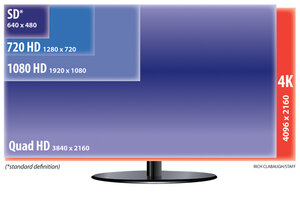4K TV: Theater quality in your living room
4K could be the next big leap for TVs. But do we really need a "higher definition" picture?

True 4K televisions cram in more than four times as many pixels as today's HD TVs.
Rich Clabaugh/Staff
When high-definition televisions first rolled out, the difference was obvious. Department stores bragged about how HDTVs could reveal every bristle on a polar bear's back, every bead of sweat on a quarterback's brow. TV picture quality soon doubled again, as 720p video – still the standard for HD broadcasts – gave way to 1080p – the resolution for Blu-ray discs and some on-demand video.
This summer, TV images will leap forward once again. Sharp, Toshiba, and LG each have announced 55- to 84-inch televisions with crystal-clear pictures that rival even theater screenings. They call this new higher-definition standard "4K."
Simply put, 4K and its close cousin Quad HD quadruple the number of pixels packed into 1080p video, elevating image quality to the equivalent of mint-condition 35mm film.
"Right now, this is more of a distant opportunity for most people," says Steve Koenig, director of industry analysis for the Consumer Electronics Association.
Most Americans have already upgraded to high definition and won't be ready to buy another TV for several years, he says. When the generation turns over, shoppers can look forward to premium features, such as Internet connections and 3-D, coming baked into most televisions.
However, 4K will likely remain the gold standard in TV – for better or worse.
Hollywood stumbles toward digital
A few decades ago, a cadre of directors had soured on film stock: It's cumbersome, fragile, takes time to develop, and, once complete, costs a great deal to ship out to theaters. What if movie crews replaced film cameras with digital ones, they wondered. Cinemas could then download new attractions.
By the late 1990s, HD technology finally caught up with this vision.
Director George Lucas, a digital proponent, took the lead. His second "Star Wars" prequel, "Attack of the Clones," stood as one of the first high-profile movies to be shot entirely in 1080p. But there was a problem. A keen-eyed audience could see the difference.
"I am sure I will hear from countless fans who assure me that 'Episode II' looks terrific, but it does not," wrote Roger Ebert in his 2002 review. "At least, what I saw did not. It may look great in digital projection on multiplex-size screens, and I'm sure it will look great on DVD, but on a big screen it lacks the authority it needs."
Hollywood needed a higher resolution. By 2005, the industry decided on 2K and 4K. As their names imply, the new resolutions are roughly 2,000- and 4,000-pixels wide, respectively. (In a confusing move, these names flip the normal practice, where 720 and 1080 instead measure the height of images. Either way, 4K doubles both the height and width of 1080p.)
Looking for ways to resuscitate TV sales
As "Avatar," "The Social Network," and the digitally remastered "Blade Runner" all reached theaters in full 4K, TV manufacturers took notice.
Television sales have slumped in the past few years. "Our forecasts show that, really, the party is over for the upgrade to HD and to flat panel," says Mr. Koenig.
Companies have tried to resuscitate sales by pushing features such as 3-D, yet with such a small catalog of 3-D movies and the need for expensive, battery-powered glasses to view them, Koenig doesn't expect a turnaround anytime soon.
Groping for anything that will get Americans excited about buying TVs again, Sharp, Toshiba, and LG hollered: Bring in the 4K TVs!
Offering a theater-quality picture on a living-room-sized screen addresses two problems at once. First, it appeals to consumers' proven love for better-quality video – although this may be a specious argument. In a missive titled "Why 4K TVs are stupid," home theater expert Geoffrey Morrison explains that at a normal seating distance of 8 feet from a TV, the human eye cannot tell the difference between a 720p, 60-inch television and a 1080p, 60-inch set. You can only distinguish the two by scooching the couch closer or by buying a larger TV. If that's the case, he says, why bother with 4K?
The second pitch holds more water: 4K solves several of the problems with 3-D TVs. Manufacturers already make 3-D televisions that do not require any glasses. Most pull off this effect by aiming half the pixels at your left eye and half at your right. But by splitting up the screen, such TVs chop their resolution in half. Cutting up a 1080p TV leads to distracting lines and image problems. With 4K, though, these quirks are imperceptible.
Improving 3-D technology is the one case where Mr. Morrison says 4K TVs are "a good idea; one could say it's even a requirement."
When the first crop of 4K TVs goes on sale this year, early adopters will face a familiar dilemma: What can I watch on this thing?
Blu-ray players will soon "upconvert" 1080p video to look good on a 4K screen, but true 4K discs won't arrive until later this year, if not next year. Sony, which offers a 4K home projector, plans to make its upcoming movie "The Amazing Spider-Man" into the first 4K Blu-ray.
With these complications – plus the price, which few manufacturers have yet to announce – Koenig says that 4K TVs will need to simmer for a while before they're ready to serve. Don't expect to factor in 4K right away – but maybe by your next TV purchase.
For more on how technology intersect daily life, follow Chris on Twitter @venturenaut.

